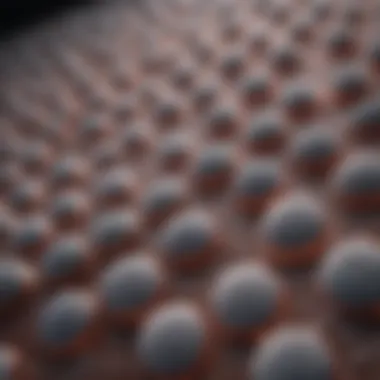Antimicrobial Filters: Safety and Effectiveness


Intro
In our rapidly changing world where health and safety concerns are at the forefront, antimicrobial filters present a valuable opportunity. They play a pivotal role in maintaining cleanliness and preventing pathogens from spreading in various environments. Their importance extends from hospitals, where every minute detail can save lives, to home settings facilitating better indoor air quality. But what exactly are antimicrobial filters? How do they work? And what makes them a necessary tool in today’s health-conscious society?
This exploration dives into the mechanisms and materials behind these filters, looking closely at how they can effectively combat harmful microorganisms. We will investigate their practical applications across different industries and consider their future potential in enhancing public health. By dissecting the basics of antimicrobial filtration, we aim to offer a comprehensive overview that captures the attention of students, researchers, educators, and professionals alike.
Foreword to Antimicrobial Filters
In an age where pathogens are a looming concern, the importance of antimicrobial filters cannot be overstated. These filters, which serve as barriers against bacterial and viral contaminants, have risen to prominence in a variety of settings, from hospitals to residential homes. Their significance lies in their ability to enhance safety by improving air and water quality, thereby reducing the risks associated with harmful microorganisms.
Definition and Purpose
Antimicrobial filters are designed to inhibit or eliminate the growth of microorganisms that can lead to disease. These filters can be found in several forms, including air filters used in ventilation systems and water filters that purify drinking water. The primary purpose of these filters is to safeguard health by removing pathogens from the environment. They employ specialized materials or coatings that release biocidal agents or use mechanical means to trap contaminants. For example, a typical HEPA filter can capture particulates, while newer variants may include silver nanoparticles that possess antimicrobial properties.
Employing these filters offers numerous benefits such as minimizing the spread of infectious diseases, improving indoor air quality, and ensuring safer drinking water. Their broader application in both public health domains, such as hospitals, and private settings underlines their versatility and critical role in safeguarding health. However, it’s important to consider aspects like maintenance, replacement frequency, and potential resistance mechanisms as part of the broader discourse on their use.
Historical Context and Development
The concept of antimicrobial surfaces isn't brand new, as practices can be traced back centuries. The use of certain materials for their microbial resistance was noted even in ancient times, like the use of copper for its hostile effects on bacteria. However, the modern development of antimicrobial filters gained momentum in the late 20th century when advances in material science began to enable more effective and longer-lasting solutions.
The journey began alongside the recognition of the need for improved infection control, especially in healthcare settings. As research progressed, scientists developed various filter types incorporating diverse technologies that not only filtered out particles but also actively killed or neutralized harmful microbes. This evolution was spurred by outbreaks of diseases that underscored the vulnerabilities of existing filtration systems. Today, antimicrobial filters are integral to many systems in hospitals where maintaining sterile environments is crucial.
Throughout the years, numerous innovations have arisen, like the integration of nanotechnology. With nanoparticles like silver being embedded into filter materials, manufacturers have taken antimicrobial effectiveness to a whole new level. Despite challenges, including regulatory hurdles and cost concerns, the field continues to evolve, offering promising solutions to enhance safety in various environments.
Mechanisms of Action
Understanding the mechanisms of action behind antimicrobial filters is crucial, as it reveals how these technologies actively combat microbial threats. By delving into the intricacies of how these filters work, one can appreciate their vital role in enhancing safety across various environments. The mechanisms can be broadly classified into physical filtration principles, biocidal activity, and how various materials interact with microorganisms on a microscopic level. Each of these elements not only highlights the effectiveness of antimicrobial filters but also presents certain benefits and considerations that are essential for their application.
Physical Filtration Principles
Physical filtration serves as the first line of defense against airborne or waterborne pathogens. The primary principle is to physically remove contaminants from air and liquids through sieving and trapping mechanisms. This process can be likened to using a net to catch fish; the size of the mesh determines what gets through. One must consider several materials, including fiberglass, activated carbon, and membrane technologies, which vary in effectiveness based on their structure and sizes of pores.
- Fiberglass filters: These are commonly used in air purifiers due to their ability to capture large particles effectively.
- Activated carbon filters: Known for their adsorption capabilities, they excel in removing volatile organic compounds.
- Membrane filters: These can achieve ultra-fine filtration, suitable for applications requiring the removal of bacteria or small viruses.
Each method has its pros and cons, making understanding the specific requirements of an application key. For instance, while membrane filters may effectively filter out bacteria, they might be less efficient in removing larger particles, which might require a multi-layered approach for optimal results.
Biocidal Activity and Modes of Action
Beyond mere physical removal, antimicrobial filters often employ biocidal materials that actively kill or deactivate bacteria, viruses, and other pathogens. Different biocidal agents have been developed, including silver nanoparticles, copper ions, and other chemical additives. The modes of action of these agents can vary considerably:
- Disruption of cell membranes: Many biocides work by breaking down the cellular integrity of microorganisms, leading to cell death.
- Inhibition of enzymatic processes: Certain biocidal substances can interfere with the enzymes that are critical for microbial survival, rendering them inactive.
- DNA damage: Some advanced materials can penetrate microorganisms and cause damage to their DNA, preventing replication.
This multi-faceted approach enhances the overall filtration effectiveness. Notably, the phenomenon of synergistic effects can be observed when filters combine physical and biocidal methods, leading to a broader range of microbial control.
Material Interactions at the Microbial Level
The interaction between filter materials and microorganisms is an area ripe with emerging research. The efficiency of an antimicrobial filter does not solely hinge upon its format or composition but also on its fine-tuned interactions at the molecular level. Understanding these interactions offers insights into ways to enhance filter design and functionality.
For instance, some materials possess intrinsic antimicrobial properties; they can actively engage with microbes in a way that mitigates their viability. Factors influencing these interactions include:
- Surface charge and hydrophobicity: The charge on filter materials can significantly affect microbial adhesion and thus, filtration efficiency. Hydrophobic surfaces may repel water, affecting the behavior of microbes in water filtration.
- Porosity and surface area: A higher surface area can facilitate more interactions with microbes, leading to enhanced capture and inactivation rates.
- Functionalization with antimicrobial agents: By modifying surface characteristics at the molecular level, products can be designed to improve their antimicrobial capabilities further.
"Antimicrobial filters are akin to the armor of a knight, robust in function yet delicate in intent, showcasing how fundamental science impacts practical applications."
Types of Antimicrobial Filters
Understanding the various types of antimicrobial filters is essential in grasping their role in enhancing safety within our environment. Each type of filter serves its unique purpose, tailored to meet specific needs across different applications. The effectiveness of these filters hinges on their design and materials, making it critical to examine the nuanced differences among air, water, and surface filters. This section dives into each category, elucidating their significance and advantages in tackling microbial threats.
Air Filters
Air quality profoundly impacts our health and well-being. Antimicrobial air filters are pivotal in trapping harmful microorganisms like bacteria, viruses, and fungi found in indoor environments. Primarily used in HVAC systems, these filters not only improve the air we breathe but also reduce the risk of airborne diseases.


- Benefits:
- They can substantially lower the incidence of respiratory illnesses by filtering out pathogens from the air.
- Enhanced performance through layers of materials like HEPA technology intermixed with antimicrobial agents.
For example, a hospital might employ these filters in patient rooms to minimize pathogen transmission. Air filters are particularly valuable in densely populated areas, helping to combat pollution by filtering particulates while also inhibiting microbial growth.
Water Filters
Access to clean water is a cornerstone of public health. Antimicrobial water filters address the essential need for safe drinking water by eliminating harmful microorganisms that might be present. These filters often incorporate a series of physical barriers and chemical treatments to deactivate microbes.
- Importance:
- They play a vital role in preventing waterborne diseases which can have severe health impacts.
- Flexibility in usage from household filters to larger-scale municipal systems.
For instance, some families rely on pitcher filters containing activated carbon and silver ions, providing an easy solution to purify drinking water from harmful substances. Moreover, industries can use these filters in manufacturing processes where water safety is crucial, ensuring product quality and public health.
Surface and Point-of-Use Filters
The proliferation of microbial contamination on surfaces necessitates innovative solutions. Antimicrobial surface filters and point-of-use filters target contamination points, providing an immediate line of defense against unwanted microbes. These filters can be integrated into everyday products or attached to specific water sources.
- Advantages:
- Rapid action in cleaning surfaces, minimizing the risk of cross-contamination in spaces like kitchens and hospitals.
- Point-of-use filters can be employed in faucets, giving an extra layer of purification directly where needed.
As a practical example, consider a food establishment where staff can wipe surfaces with antimicrobial cloths treated with embedded filter technology. This application reduces the risk of illness transmission, safeguarding both employees and customers.
In summary, each type of antimicrobial filter serves a distinct purpose in improving health outcomes and enhancing environmental safety. As we delve deeper into the applications in subsequent sections, the importance of these filters, spanning air, water, and surfaces, becomes ever more apparent, highlighting their critical role in our surrounding environments.
Applications of Antimicrobial Filters
The utilization of antimicrobial filters spans a diverse array of settings, from hospitals to homes. Their role in improving safety and health outcomes is significant, especially in times when infectious diseases pose a considerable risk. Various applications reinforce the need for enhanced protection in environments where pathogens are prevalent. This section delves into the specific applications of these filters, demonstrating their importance and versatility.
Healthcare Settings
In healthcare settings, the stakes are incredibly high, where infections can lead to severe consequences. Antimicrobial filters serve as a crucial line of defense.
Hospital Environments
In busy hospital environments, the transmission of airborne pathogens can lead to outbreaks of hospital-acquired infections. Antimicrobial filters used in air conditioning systems and other ventilation strategies help minimize this risk.
The key characteristic of these filters is their ability to not just catch particulates but also to neutralize harmful microbes. This makes them a popular choice in such critical areas. A unique feature of these filters is their biocidal properties which cut down the microbial load in the air, proving especially beneficial in surgical wards and intensive care units. However, the costs and maintenance involved can be a drawback, as they require regular monitoring to ensure they remain effective.
Surgical Applications
In the operating room, where precision and sterility must be maintained, surgical applications of antimicrobial filters become indispensable. They are engineered to remove pathogens from the air, thus reducing the risk of post-surgical infections.
The key characteristic here is the controlled environment they create, which is essential for successful surgeries. The unique feature of these filters is their capacity to function in high-efficiency particulate air (HEPA) settings, which means they not only filter air but also provide a sterile environment. While effective, these systems can be costly and may require specialized training for optimal utilization.
Laboratory Safety
Laboratories deal with potential biohazards extensively. Antimicrobial filters provide another layer of protection in these settings, ensuring that air quality is maintained and that experiments can occur without contamination.
The key characteristic is the strict adherence to biosafety standards, often required for research involving pathogens. A unique feature of these filters is their compatibility with various laboratory equipment, providing flexibility in applications. One must consider, however, the thoroughness with which these filters should be tested to suit specific laboratory conditions.
Commercial and Industrial Uses
The commercial and industrial arenas present unique challenges where microorganisms can pose risks to both workers and products. Antimicrobial filters play a vital role in maintaining safety protocols.
Food Processing
In food processing, the presence of microbial contaminants can jeopardize food safety, leading to contamination outbreaks. Antimicrobial filters are strategic in preventing such risks by ensuring that air quality remains at optimal levels.


They are beneficial as they can reduce spoilage and extend shelf life, a major concern for producers. A unique feature lies in the materials used, which often allow for easy cleaning and maintenance, enhancing food safety management. However, it might lead to higher initial costs due to specialized installation processes.
Pharmaceutical Manufacturing
In the realm of pharmaceutical manufacturing, ensuring a sterile environment is paramount. Antimicrobial filters help in achieving the strict cleanliness standards needed in this industry.
The key characteristic is their precise filtration capabilities, which are essential for protecting the integrity of drugs. The unique feature is the tailored design for specific production processes, highlighting adaptability. However, the complexity of what these filters must handle can necessitate frequent updates or replacements, complicating budgets.
HVAC Systems
In addition to the more specialized settings, HVAC systems in buildings benefit greatly from antimicrobial filters. These systems are often responsible for maintaining air quality in office buildings, schools, and public facilities.
The key characteristic of these filters in HVAC applications is their ability to enhance indoor air quality, impacting the health of occupants. This unique feature provides a protective benefit against allergies and respiratory issues. Notably, regular upkeep is necessary for these systems to maintain efficacy, which can be a drawback for some institutions.
Residential Applications
As home environments try to enhance hygiene levels, antimicrobial filters are beginning to play a more significant role in residential applications.
Home Air Quality
Indoor air quality can greatly affect overall health. Antimicrobial filters in home systems effectively reduce airborne contaminants, leading to a healthier living space.
The key characteristic is their accessibility to average homeowners, making them an attractive choice. A unique feature is the ability to capture various allergens, which is valuable for individuals with sensitivities. However, they might require periodic replacement, which adds ongoing expenses for upkeep.
Water Purification
For homeowners concerned about the quality of drinking water, antimicrobial filters in water purification systems serve as an essential safeguard against contaminants.
The key characteristic of these systems is their dual action of filtering out particulates and neutralizing microbes. This unique feature offers peace of mind for families, particularly in areas where water quality is a concern. Despite their benefits, the initial installation costs may be intimidating to some.
Surface Sanitization
With surfaces being critical points for microbial transmission, incorporating antimicrobial filters into surface sanitization processes can be highly effective. These filters can help maintain cleanliness in high-touch areas like kitchens and bathrooms.
The key characteristic is the comprehensive nature of their protection, preventing the spread of germs across surfaces. A unique feature is their ability to be integrated into various cleaning devices. Though valuable, one must consider that they are not a replacement for conventional cleaning methods—rather, they complement them.
Performance and Effectiveness
The performance and effectiveness of antimicrobial filters play a crucial role in ensuring public health and safety. In various environments—be it hospitals, homes, or commercial spaces—the ability of these filters to perform as advertised can make a significant difference in minimizing the spread of harmful pathogens. Effective filtration can help mitigate health risks, enhance air and water quality, and improve overall safety in everyday settings.
To really grasp how performance is evaluated, one must consider several specific elements, including the filter's efficiency, longevity, and material composition. These criteria don't merely result in technical specifications; they have tangible impacts on user confidence and overall public perception of antimicrobial filter technologies.
Testing and Certification Standards
The credibility of antimicrobial filters largely hinges on rigorous testing and certification standards. Various organizations have established these benchmarks to evaluate how well a filter performs against specific pathogens and conditions. For example, tests might assess the reduction of bacteria or viruses in air or water. Such certifications often come from regulatory bodies like the Environmental Protection Agency (EPA) or the American Society for Testing and Materials (ASTM).
Moreover, standardized testing methods, such as the ASTM F2834 or ISO 22196, outline the procedures needed to quantify a filter's antimicrobial activity effectively. These certifications are not just ticking boxes; they cultivate trust among manufacturers and consumers. A filter that boasts certifications from recognized organizations signals reliability and assures users of its safe application.
"In an era where safety is paramount, certification becomes a non-negotiable aspect of any effective antimicrobial filter."
Limitations and Considerations
Despite the advantages, no antimicrobial filter is perfect. Understanding their limitations is vital for users aiming to make informed decisions. First off, there's the question of lifespan; many filters show a decrease in effectiveness over time or upon exposure to certain environmental conditions.
In addition, not all filters eliminate every type of microorganism. Filters may perform exceptionally well against bacteria but are less effective against viruses or fungi. This selective efficacy means that consumers need specific solutions tailored to their distinct needs.
Also, while antimicrobial filters are beneficial, they should not be viewed as a silver bullet. They complement existing sanitation practices rather than replace them. Proper maintenance and periodic replacement are essential to keep the filters performing effectively.
Lastly, environmental considerations also come into play. Many filters are not made with sustainability in mind, leading to increased waste and a potential negative impact on ecosystems. Users frequently grapple with the challenge of balancing antimicrobial efficacy with long-term environmental responsibility.
In summary, while antimicrobial filters represent a significant advancement in enhancing safety, it’s critical to acknowledge their performance metrics and limitations. Only then can users properly assess their value in various applications.


Microbial Resistance and Future Challenges
Understanding microbial resistance has become increasingly vital, especially as we delve into the world of antimicrobial filters. These filters are tasked not just with trapping annoying pollutants but also with curbing the growth and spread of potentially harmful microorganisms. With the continuous evolution of microorganisms, the issue of resistance only deepens. Ignoring it can undermine the very purpose of antimicrobial filtration. Therefore, a careful exploration of both the resistance mechanisms and the resultant implications for filter design is necessary.
Resistance Mechanisms of Microorganisms
Microorganisms, including bacteria, fungi, and viruses, possess a cunning ability to adapt. This adaptability can result in resistance to antimicrobial treatments, including those provided by filters. The following points highlight key mechanisms through which microorganisms develop resistance:
- Genetic Mutation: Some bacteria can mutate rapidly, allowing them to shift their biochemical pathways. This evolution can render previous antimicrobials ineffective against them.
- Horizontal Gene Transfer: This process involves the transmission of resistant genes between organisms. For instance, a bacterium that acquires a resistance gene from another can swiftly become impervious to a specific filter treatment.
- Biofilm Formation: Bacteria often band together in communities, encasing themselves in a protective layer known as a biofilm. This makes it challenging for antimicrobials to penetrate, thereby allowing the bacteria to thrive even in the face of antimicrobial filters.
The implications of these mechanisms are far-reaching. As microorganisms outsmart traditional strategies, it becomes crucial to keep an eye on how filters can evolve to stay one step ahead.
Impact on Antimicrobial Filter Design
The ongoing battle between antimicrobial filters and resistant microorganisms challenges scientists to rethink filter design. Here are some considerations that could shape the future of this technology:
- Development of Dual-Action Filters: Filters that not only capture microorganisms but also actively disrupt their cellular structures could prove effective. For example, integrating novel materials that provide both physical filtration and chemical antimicrobial properties may enhance overall effectiveness.
- Smart Filtration Systems: With advances in technology, sensors embedded in filters could monitor microbial levels in real time. Such data could inform users when a filter is becoming ineffective or when it is underperforming due to increased resistance levels.
- Customizable Solutions: The one-size-fits-all approach may soon be obsolete. Tailoring filters for specific environments (like healthcare versus residential settings) could increase their effectiveness. Custom designs could take microbial resistance patterns into account, adapting to the particular challenges present in each setting.
Microbial resistance is a moving target, and while traditional methods have served us well, the future demands a more nuanced approach in filter design.
In the years ahead, a profound understanding of resistance mechanisms and a commitment to innovative design solutions will be essential for antimicrobial filters to maintain their role as guardians of our air and water quality.
Environmental Impact of Antimicrobial Filters
The relevance of understanding the environmental impact of antimicrobial filters cannot be overstated, particularly in light of global efforts to enhance sustainable practices. Antimicrobial filters, while enhancing safety by controlling the spread of harmful microorganisms, also bring up important considerations regarding their lifecycle, material usage, and long-term effects on the ecosystem.
Sustainability Considerations
Sustainability is a pressing concern in various sectors today, and antimicrobial filters are no exception. The materials used in these filters often include metals like silver and copper, which are known for their antimicrobial properties. However, the extraction and processing of these materials consume resources and may lead to significant environmental degradation. In the context of sustainability, it’s essential to evaluate the balance between health benefits and environmental costs.
For instance, the production processes for silver-based filters can result in emissions harmful to freshwater ecosystems. This begs the question: how can manufacturers strike a balance between effectiveness in pathogen removal and minimizing their ecological footprint? One potential line of action is the development of bio-based materials which offer antimicrobial properties without the environmental tax associated with traditional methods. These eco-friendlier alternatives not only maintain efficacy but also meet consumer demand for sustainability.
Additionally, lifecycle assessment (LCA) is a crucial tool in gauging the sustainability of these products. It considers every stage in a filter's existence, from raw material extraction to manufacturing, use, and finally disposal. Implementing LCA during product development can guide manufacturers in making informed decisions that align with sustainable practices.
"In a world where environmental responsibility is becoming increasingly critical, prioritizing sustainability in antimicrobial filtration could pave the path for greener solutions that benefit public health and the planet alike."
End-of-Life Management
How we handle the disposal of antimicrobial filters significantly impacts the environment. Many filters, once used, end up in landfills, raising concerns about leaching of antimicrobial substances into soil and groundwater. This has the potential to disrupt local ecosystems and could contribute to the evolving problem of antimicrobial resistance.
To tackle these issues, effective end-of-life management strategies are necessary. Here are some potential approaches:
- Recycling Programs: Encouraging recycling can limit waste and reduce the need for new materials. Some companies are beginning to implement take-back programs for used filters, facilitating proper recycling.
- Biodegradable Materials: The development of biodegradable filters can greatly mitigate disposal issues. As these materials break down, they should not leach harmful substances into the environment, thus protecting ecosystems.
- Public Education: Raising awareness among consumers and industries regarding responsible disposal methods can foster a culture of environmental stewardship. This can include guidelines for safe disposal and the promotion of recycling habits.
In summary, the environmental implications of antimicrobial filters should not be an afterthought. By emphasizing sustainable practices and responsible end-of-life strategies, we can harness the benefits of these filtration technologies while safeguarding our planet for future generations.
Culmination
Antimicrobial filters serve as a crucial component in the enhancement of safety across numerous environments. Their multifaceted applications and evolving technology stand testament to their necessity in contemporary society. In this article, we've discussed how these filters not only improve air and water quality but also play a key role in protecting health in various settings from healthcare to residential applications. They address pressing concerns around microbial safety, providing a fortified frontline against pathogens that could compromise human health.
When looking at the benefits of antimicrobial filters, one can note that they significantly reduce the transmission of harmful microorganisms. By utilizing specific materials and innovative designs, these filters disrupt the lifecycle of bacteria and viruses. The importance of implementing such technologies cannot be overstated, especially in our current climate where health safety is paramount.
Additionally, it's vital to consider the challenges that lie ahead. With the advances made thus far, researchers and engineers must continuously adapt to the changing landscape of microbial resistance and the environmental impact of these filters. Hence, investing in better materials and sustainable practices becomes indispensable in ensuring a healthier future without compromising our planet's resources.
"The future of antimicrobial filters is not only in their effectiveness but also in their sustainability and adaptability to new challenges in health safety."
In summary, the incorporation of antimicrobial filters into everyday use embodies a proactive approach to health and environmental safety. Their importance spans not just technological advancements but also cultural shifts towards safety awareness and environmental stewardship.
Summary of Key Points
- Role in Health: Antimicrobial filters serve as vital tools in combating pathogens, especially crucial in healthcare settings.
- Applications: Their versatility spans air filtration, water purification, and surface sanitization, among others.
- Materials and Effectiveness: The variety of materials used enhances effectiveness in various environments while addressing microbial threats.
- Environmental Considerations: Managing the environmental footprint of these filters is as critical as their effectiveness.
- Future Challenges: Ongoing research is critical to address microbial resistance and sustainability concerns.
Future Directions in Antimicrobial Filtration
The journey of antimicrobial filtration technology does not stop here; several prospective paths warrant attention:
- Innovative Materials: The exploration of bio-based and biodegradable materials could potentially decrease the environmental impact of filters while maintaining efficacy against microbes.
- Smart Filters: Integrating technology, such as sensors for real-time monitoring of filter performance, could enhance maintenance and operational effectiveness.
- Customization: Tailoring filters for specific applications or environments could maximize their potential and effectiveness.
- Educational Initiatives: Enhancing public understanding and acceptance of the need for such filters will further drive their integration into standard practice.
- Collaboration in Research: Multi-disciplinary efforts in academia and industry will be essential to tackle the evolving challenges presented by microbial resistance and environmental sustainability.







